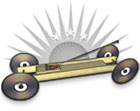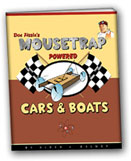Mousetrap Vehicles: Science Concepts
Earth shattering secrets for building record setting and winning mousetrap cars and racers. Here you will find all the latest and greatest untold construction secrets so you can build your very own mousetrap vehicle.
Motion Basics
In physics, motion is a change in position of an object with respect to time. Change in action is the result of an unbalanced force. Motion is typically described in terms of velocity, acceleration, displacement and time. Learn all about motion and how it applies to mousetrap powered vehicles.
Friction
Friction is the force that resists sliding or rolling of one solid object over another. Some friction is beneficial, such as the traction used to walk without slipping. Most friction, though, is undesirable opposition to motion, such as between moving parts of machines. Learn all about friction and how it applies to mousetrap powered vehicles.
Fluid Friction
Fluid friction describes the frictional forces between layers within a viscous fluid that are moving relative to each other. Learn all about fluid friction and how it applies to mousetrap powered vehicles.
Newton's Laws
Newton's laws of motion are three physical laws that form the basis for classical mechanics. They describe the relationship between the forces acting on a body and its motion due to those forces. Learn all about Newmton's Laws and how they applies to mousetrap powered vehicles.
Momentum
Momentum is inertia in motion. Momentum is the combination of an objects mass and its instantaneous velocity combined. Learn all about momentum and how it applies to mousetrap powered vehicles.
Center of Mass
The center of mass is the mean location of all the mass in a system. In the case of a rigid body, the position of the center of mass is fixed in relation to the body. Learn all about center of mass and how it applies to mousetrap powered vehicles.
Weight Distribution
Weight distribution is how the weight of an object is spead out or distributed over it's area. Learn all about weight distribution and how it applies to mousetrap powered vehicles.
Rotational Inertia
In classical mechanics, moment of inertia, also called mass moment of inertia, rotational inertia, polar moment of inertia of mass, or the angular mass, is a measure of an object's resistance to changes to its rotation. It is the inertia of a rotating body with respect to its rotation. Learn all about rotational inertia and how it applies to mousetrap powered vehicles.
Energy
Energy is the capacity of a physical system to perform work. The law of conservation of energy says that the total energy of a system remains constant, energy can not be created and/or destroyed but can be changed to one form and another. Learn all about energy and how it applies to mousetrap powered vehicles.
Power Output
In physics, power is the rate at which work is performed or the rate at which energy is converted from one form to another. Learn all about power output and how it applies to mousetrap powered vehicles.
Mechanical Advantage
Mechanical advantage is a measure of the force amplification achieved by using a tool, mechanical device or machine system. Ideally, the device preserves the input power and simply trades off forces against movement to obtain a desired amplification in the output force. Learn all about mechanical advantage and how it applies to mousetrap powered vehicles.
Torque
Torque causes things to change their state of rotation. A torque is a force applied some distance from a pivot point. Learn all about torque and how it applies to mousetrap powered vehicles.
*Can't find what you’re looking for? Ask Doc Fizzix »




